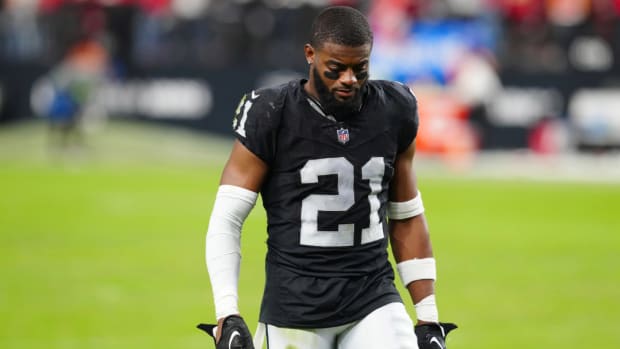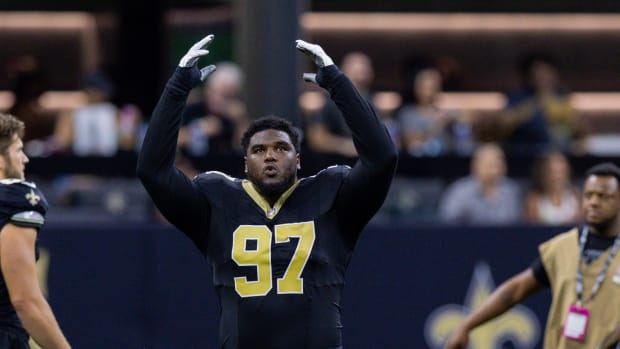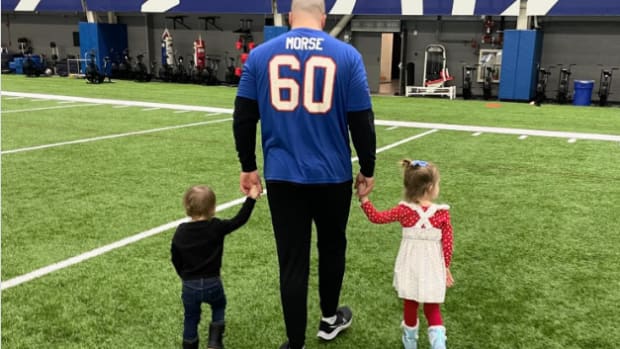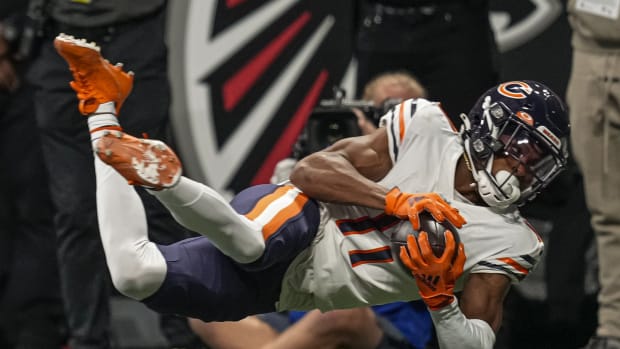Concussions, helmet hits all part of vicious circle or football injuries
There aren't any injuries we haven't heard, but sometimes it seems like it. Oblique strain? High ankle sprain? Those are new terms, or more specific terms for injuries that have always been around. The increasing speed and power of the game occasionally brings a new mechanism, but the body is the body. So why have we seen several brachial plexus injuries this season, most notably in Joseph Addai, and what the heck is the brachial plexus? When I want to learn about things, I'm lucky enough to be able to talk to some of the best in the business, so I went to Dr. Robert Watkins, one of the world's leading spinal surgeons, from Marina Del Ray Hospital in California.
I started by asking just what the brachial plexus is and how it gets injured. "Cervical spinal nerves exit the neck and join together to form the brachial plexus, which then branches off into the peripheral nerves that travel down the arm to innervate the muscles," he explained. "The brachial plexus is most vulnerable to injury in young people through a stretch injury when the head is forced away from the affected plexus and arm."
We've heard of 'stingers' and 'burners' for years, so I asked if this is the same thing. "No," said Watkins. "A stinger is compression of the most sensitive part of a specific spinal nerve -- C5 to be specific -- in the window where the nerve exits the spinal canal. Typically, this is due to direct compression on the head while it is turned toward the affected arm. The load on the head closes down the window and pinches a specific spinal nerve."
Since it seems like these nerve injuries are slow healing and tough to treat, I asked how players could avoid them altogether. "Three things can help prevent spinal injuries in athletes," said Watkins. :"First, they should be doing core stabilization exercises. Strong and coordinated trunk muscles can keep your spine in proper alignment. Second, there could be a need for equipment modification. Proper shoulder pads and rolls can help prevent the neck from being loaded in a compromised position. Finally, there needs to be a focus on rules and education. The neck is most vulnerable to a spinal cord injury with a direct load to the top of the head. The cervical spine is the weakest part of the connection from the head to the feet and most likely to absorb the load from a direct force to the top of the head. Players need to be taught proper tackling techniques to "see what they hit" and spearing needs to be not tolerated due to the risk of the spearer of sustaining a cervical spine injury, as well as, the injury that can be delivered to the other player."
All in all, it seems that this injury and the spate of concussions we've seen might be interconnected in some ways. A direct hit with the crown of the helmet might cause a concussion in the player giving the hit or the one taking it. If the hit is just off center and the head is forced to the side, it could cause a brachial plexus injury, or worse, a spinal issue. The NFL's emphasis on minimizing head-to-head contact might have more value than we thought. So with that new knowledge and a thanks to Dr. Watkins and to my friends at the Kerlan-Jobe Clinic, let's get to the injuries:
There's nothing standard about the way the Adrian Peterson inactive happened. Peterson was not, at any point, expected to miss Monday's game ... until they announced it. There's nothing about watching him in pregame, there's nothing about extra treatment, just pow -- he's out. Peterson had dealt with an ankle sprain that bounced off him like bullets off Superman, but then a bruise to the thigh puts him out? It's very confusing. Worse, Peterson was limited on Wednesday with ... a knee problem! The knee problem, reports said, was the same thing as the thigh, probably. Even beat reporter Judd Zulgad, who always has the scoop in Minnesota, was confused. Fantasy players are upset by how it happened much more than that it did happen. Unfortunately, it's the how that makes it impossible to know Peterson's status for this Sunday. Watching the practice reports, checking sources and reading the OIR wasn't enough last week, so this week, be ready. Worst of all, the Vikings have a night game on Sunday, making a Plan B even more difficult.
The reverse situation to Peterson's was Brett Favre's "miracle on ice" return. Once more onto the frozen tundra for No. 4, but this time that's where it ended, head first. Favre was thrown to the turf and listed as out with a concussion, though watching the replay you'll see a couple things. First, Favre's head does hit the turf but doesn't bounce. That's not an indication that it wasn't a hard hit, just that there wasn't the normal "whip" you see in QB sack concussions. Second, as Favre goes down, seemingly fumbling on the play, he catches himself with his right arm, precisely the kind of movement that would put pressure on his shoulder. As he lay on the turf, Favre pulled the arm in and could be seen at one point pointing while talking to the trainers. Favre was not kept down for any extended period of time and at no point on the sidelines did the doctors appear to be doing any sort of concussion assessment. Granted, we didn't see everything, but there are a lot of oddities stacking up.
We should also go back to the shoulder injury, widely reported as a sternoclavicular sprain, but never confirmed by anyone aside from Favre. Two doctors e-mailed me on Monday evening, saying there was no way, even with a guided nerve block to help alleviate the pain, that Favre would be able to play through that injury. Moreover, one of them pointed out that Favre's first pass, a crossbody throw that went low and outside to his receiver, was precisely the type of motion that would most tax the SC joint. Quick, try that motion at home and put your hand right on your SC joint.
I'm not one for wild conspiracy theories, but I do like facts. The facts we have just don't add up as presented. I doubt we have all of them and likely never will, but I'll say this for Favre -- he understand mythology like no athlete in the history of football. I think he saw Monday Night Football as his chance at a bloody sock game.
The question this week hasn't been whether Austin Collie should go on IR; all but that radical few who actually suggest rubbing some dirt on it agree that the danger to Collie's brain far outweigh the gains he gives the Colts offense. Instead, the question has been whether Collie's career is now in jeopardy.
There's simply no way to answer that. Each concussion is different and each person with a concussion responds differently. While it's possible to grade concussions using either the standard Cantu scale or one of the other medically established scales, the only way to do so is retrospectively. We don't know until well after how serious the concussion was because we can only measure the body's response to it. Sure, we could put accelerometers in helmets, something I'd be in favor of doing, especially post-concussion. We just don't know enough to do much aside from saying a player is symptom free. Even this is in question, and the Collie case is a perfect study in that.
Collie was cleared to return to activity after his first concussion in Philly, but left quickly. It's still not clear whether he returned too early and had symptoms, whether he suffered a second concussion or whether he simply "didn't feel comfortable" on the field, something an anonymous Colts official was quoted as saying after that game. When Collie returned to the field on Sunday, he had a dark visor, something he did not wear previous to the first concussion. Why the change? I was told by multiple sources that bright lights bothered Collie and he hadn't really tested what would happen when he looked up into the stadium lights. That's light sensitivity and is a symptom often seen post-concussion. If this is the case, Collie was cleared to return while still experiencing symptoms. That's not supposed to be possible under the NFL's guidelines. There's a doctor somewhere who failed Collie. Was Collie pressured to return despite his symptoms? That's likely, given this team and the big game they were facing. Was the doctor also pressured? If so, that's simply wrong and the NFL needs to fix it.
The Packers are on the outside looking in right now, saved only by the Giants' collapse last week. Now they need to win out and get a little help to make the postseason. Aaron Rodgers was back under center for the Packers on Wednesday and after missing last week, looks to be ready to play this Sunday. Knowing what we know about Collie, as I detailed above, we do have to take a harder look at Rodgers. Last week's was a big game as well, so they get some credit for that, but if someone can pressure their way back for a big game and the so-called independent consultant isn't making sure that the player is completely symptom free, what good is this added step? I'm not accusing anyone of anything here. By all accounts, the Packers have done everything by the book. This appears to be a problem of the system in place and one that can be easily fixed by a bit more transparency. Easy suggestion for tweaking the system next year - name the independent doctors who have final say, show their world-class credentials, randomly assign them, and then show which signed off on which players.
The Jets had some big news on Wednesday ... I mean on the field. It appears that Mark Sanchez has been dealing with a small cartilage tear in his shoulder. People immediately went to the wild conclusions, but let's look at what this is and isn't. Sanchez has a small tear, either in the labrum or the articular cartilage inside the shoulder. Neither is good, but on it's own, neither is devastating. Both can be fixed in the off-season and dealt with in the short term. The worries get bigger if the cartilage tear is sizeable or is paired with a more serious structural issue, like a rotator cuff tear. Even that's not devastating -- ask Drew Brees how he came back from his. Sanchez has never relied on a big arm, so he should be able to adjust quickly and keep the Jets on track. The Jets would like to lock up a playoff spot this week and get Sanchez some rest.
The Colts don't normally shut down the run, let alone shut down Maurice Jones-Drew, but that's what they did in their big win last Sunday. The question now is whether Jones-Drew's knee was the Colts' best defender. Jones-Drew has been playing with a sore knee much of the season, likely the result of a minor meniscus injury that can be corrected with minor off-season surgery. The medical staff has kept Jones-Drew very functional and the strength in his legs has helped. The Jags have been slowing Jones-Drew down in practice to keep the wear on the tear as low as possible, then unleashing him on Sunday. I asked a couple Colts defenders if they saw anything different about Jones-Drew and they felt he didn't have the same cutbacks as they've seen in the past, another indicator that the knee might be a bigger problem than thought. Jones-Drew will go on Sunday with the Jags in a must-win, but temper expectations after last week's performance. Even with a good matchup, that might be enough reason to go with Rashad Jennings again. If the Jags are eliminated, I'd expect the Jags to keep Jones-Drew on the field for awards and yardage considerations.
There's an element of luck in winning in the NFL. Avoiding injuries is a function of a great medical staff, but there's also the element that can't be controlled. Your star QB doesn't take the big hit. A player who's injury prone stays healthy for 16 games. Someone misses a kill-shot hit by a hair. Of course, that same luck can break the other way, and it takes a good team to play through the bad luck. The Saints have seen both sides of that cruel coin in the past couple seasons and it's been especially bad this season at RB. Almost all of their RBs have been sidelined at one point or another. Chris Ivory has been their most productive, perhaps only because he's been the most available. Ivory missed last Sunday with a hamstring strain despite a widely reported injection that was supposed to help get him back. The injection of platelet-rich plasma, a controversial treatment with mixed results, didn't seem to have any effect and we'll have to watch practice reports late this week to see if Ivory's made any progress. Right now, he looks like a GTD, which opens up more touches for Pierre Thomas.
Watch the DeSean Jackson game-winning punt return play again and watch as an Eagle comes slamming in, de-cleating some Giants coverage team guy and giving Jackson just the opening he needed to go down and showboat ... I mean score. That Eagle with the big hit was Jason Avant. Watch a bit closer and you'll see that Eagle stay down. Avant suffered a concussion on the play, a reminder that people giving the hits are at as much risk as the ones taking the hits. It's not that the players were moving in opposite directions, since Mythbusters took care of that one for us. It's force, applied to the brain, plain and simple. Avant's status is unknown for this week, though with the fragile Eagles WR corps, depth is an issue at all times. Avant did pass the concussion screening, so there's a solid chance he'll return this week.
Sometimes I get to have a little fun in this job. Hearing that Arian Foster missed the end of the game with "glute spasms" is one of those times. I'm sure it wasn't funny to Foster and I don't mean to make fun of any injury, but while most of the terms I came up with to describe this injury couldn't make it to a family-friendly site, I'm sure you can play along at home. Foster is leading the NFL in rushing, but doesn't have much of a lead over Maurice Jones-Drew or Jamaal Charles, so look for the Texans to do as much as they can to have some positive to put on this season. They'll try to get Foster his yardage while protecting the injury. This might cost Foster some fantasy value as he'll lose some touches, but they might hold him out of short red-zone looks to keep him from pushing too hard with that strained glute.
The Cowboys finally put Tony Romo on IR, as his collarbone fracture had not healed to a point where he could play without discomfort. He should have no issues given a few more weeks of healing time ... People often compare Jay Cutler to Brett Favre. Cutler now has a similar scar to Favre after taking one, literally, on the chin Monday night. He needed three stitches ... The Lions only know that Matthew Stafford won't be their QB in Week 16. Drew Stanton and Shaun Hill are both hurting and will both be GTDs, including who gets the start ... Peyton Hillis is "black and blue all over" according to a team source. His knee is problematic, but he's expected to play ... Mike Goodson missed practice Tuesday with an illness. This wouldn't be that notable except for the Panthers playing Thursday night ... The Broncos are playing it very tight regarding Knowshon Moreno's rib injury. He'll be a GTD and not a great option even if he plays ... Joseph Addai made it through his first few full practices in over a month, but at best he's a GTD. Even if he plays, don't expect him to get anything more than a share of the touches ... Felix Jones got kicked in the shin in last week's game. It's painful, but he'll play in a three-way RB committee this week ... Terrell Owens is done for the season after tearing his meniscus. He'll be fine in a month ... Santonio Holmes has turf toe and will be guarded during this week's practice. He becomes a risky play this weekend, with his injury and Sanchez's combining against his value ... The Chargers won't rule him out yet, but it looks like Antonio Gates is aiming at the playoffs for a return. The Chargers just have to get there ... Heath Miller is expected back Thursday night after missing a couple games with a concussion. He's not a great fantasy option as the Steelers seem to be dialing things back on their starters ... Todd Heap is back at practice, but still somewhat limited. He's not likely to get his full targets if he does play this week ... Troy Polamalu is out for the Thursday game and is expected to be out next week as well, giving him a full month of rest before returning for the playoffs, assuming the Steelers hold on to their bye position ... We won't have a video chat this week, but I'll do my best to answer questions on Twitter (@injuryexpert). Good luck to everyone playing in the Super Bowl!






































